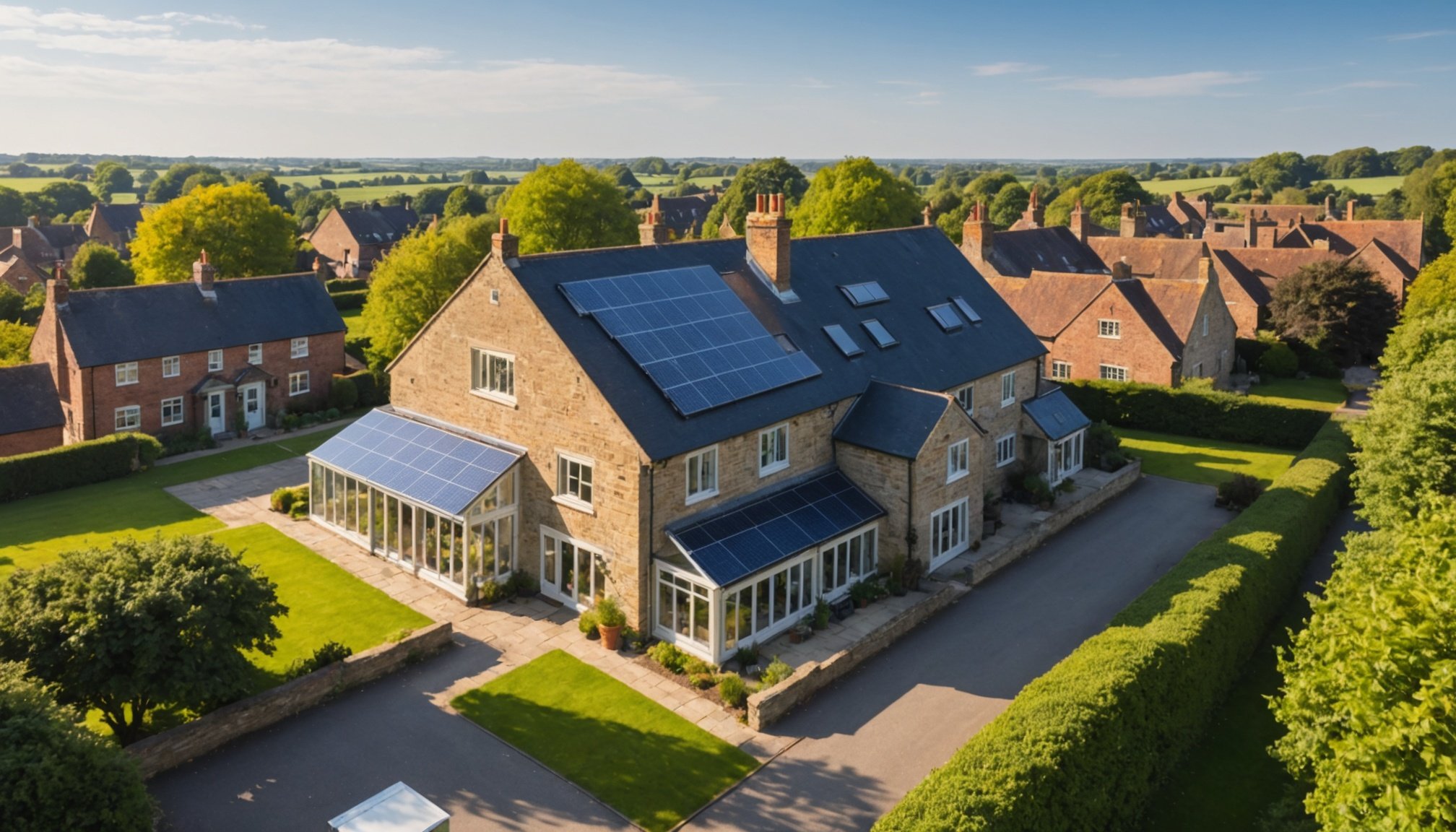Introduction to Solar Energy Solutions in Historic UK Properties
As the demand for sustainable energy solutions rises, the integration of solar energy in historic properties becomes increasingly significant. Such integration not only aids in reducing carbon footprints but also tackles energy dependency in the UK. However, maintaining the architectural integrity of these revered structures is crucial. Installing solar energy systems in a manner respectful of historical architecture demands a delicate balance between modern efficiency and historical preservation.
Historic properties present unique challenges in renewable energy integration. These often stem from their distinctive architectural features and the necessity to keep them intact. Despite these challenges, implementing solar energy can drastically enhance energy efficiency. It reduces operational costs and aligns with sustainability goals, making it a valuable consideration for long-term energy strategies.
In the same genre : Revolutionizing real estate: key approaches to embed sustainable urban farming practices
The benefits of solar energy in this context are numerous. They include increased energy independence and contribution to the UK’s broader environmental goals. Leveraging the power from a renewable source, historic properties can maintain their allure while becoming modern exemplars of energy efficiency. Embracing these solutions not only preserves cultural heritage but also fosters a sustainable future for the property and its community.
Understanding Regulatory Frameworks
Navigating the regulatory considerations for installing solar systems on historic properties in the UK requires careful attention to numerous planning permissions and laws. The regulatory environment ensures that any alterations maintain the heritage protection of these structures, balancing modern energy needs with conservation efforts.
This might interest you : Maximizing real estate value: an in-depth exploration of urban green spaces and their impact
For solar installations, specific planning permissions are often necessary. These permissions are designed to ensure that the architectural and historical integrity of the buildings remains intact. Typically, these are managed by local authorities and, in some cases, national bodies such as Historic England.
Several regulatory bodies oversee both heritage and sustainability-related concerns. These bodies ensure that solar energy systems are installed in harmony with the distinctive features of historic properties. Regulations often dictate the extent and type of solar technology permissible, ensuring visual impact is kept to a minimum.
Heritage protection laws play a crucial role, as they can both limit and guide the integration of sustainable solutions like solar energy. By understanding these laws, property owners can avoid penalties and create efficient, compliant systems. Appropriately navigating this regulatory landscape is central to successfully implementing solar energy in historic settings without legal hindrances.
Best Practices for Retrofitting Solar Solutions
Navigating the delicate balance of integrating solar technology application into historic properties requires astute attention to architectural compatibility. Astutely chosen solar solutions that enhance a building’s energy profile while respecting its historical significance are paramount.
Distinct strategies like using solar slates or integrating panels to mimic roofing materials are innovative ways to maintain the building’s aesthetic value. These solutions strive to achieve discreet installations, thereby preserving the building’s visual integrity.
Understanding different types of solar technologies suited for historic structures is essential. Photovoltaics that blend with existing materials or new thin-film technologies offer minimal visual disruption, aligning well with conservation ethics.
Installation best practices are anchored in following conservation guidelines rigorously. For example, ensuring that non-invasive installation methods, such as mounting that doesn’t penetrate historical materials, are used is crucial. Priorising existing structural features over major alterations helps maintain historical authenticity.
Installing solar technologies in historic buildings demands not only a respect for the past but innovation for the future. Through informed integration, historic properties can serve as pioneering examples of energy-smart heritage conservation. Embracing these technologies paves the way for a sustainable legacy.
Case Studies of Successful Solar Retrofits
Examining successful projects where solar energy integration has revitalised historic properties provides invaluable insights and guidance for future endeavours. By analysing specific case studies from the UK, we can understand the practical implementation and its implications for other historic sites.
One notable example is the Redhall House in Midlothian, where bespoke solar panels were installed unobtrusively. The architectural harmony was maintained, showcasing a blend of renewable energy and historical details. This integration not only enhanced energy efficiency but significantly reduced energy costs.
Another project at Mount Stewart, Northern Ireland, demonstrates the power of solar slates which mimic traditional roofing while providing modern energy solutions. Solar technology was applied in a way that upheld the building’s cultural significance, promising long-term benefits and sustainability.
These projects reflect the adaptability of solar energy systems in different environments, offering lessons on overcoming challenges during retrofitting. Lessons learned include the importance of selecting the right technology and ensuring close collaboration with conservation bodies to overcome potential barriers.
Assessments from these projects have shown marked reductions in energy consumption, reinforcing the viability of solar solutions. Ultimately, these examples inspire confidence in integrating solar energy with historic preservation.
Financial Incentives and Support Programs
Historic properties in the UK exploring solar energy installations can benefit significantly from numerous financial incentives. These incentives provide a compelling rationale to embrace renewable energy while ensuring historical conservation.
Several grants and funding opportunities exist specifically for historic structures. These initiatives are often spearheaded by local councils, government bodies, or environmental organisations, aiming to support the transition towards cleaner energy sources. Funding opportunities include subsidies for renewable energy transformations, making the initial investment in solar technology more accessible.
The UK government offers tax incentives and financial programmes, such as the Green Deal Grants, encouraging energy efficiency in historical settings. Property owners can access financing to cover installation costs, ensuring long-term savings from increased energy efficiency.
For those interested, resources like the Energy Saving Trust provide guidance on applying for grants, offering comprehensive support in navigating the financial landscape. By investing in solar energy solutions, historic properties can significantly reduce energy costs over time, achieving both environmental and economic benefits.
Through strategic use of financial support, historic properties can lead in energy-smart conservation, marrying the rich heritage with sustainability for the future.
Future Trends in Solar Energy and Historic Preservation
The evolution of emerging technologies offers promising prospects for integrating solar systems into historic properties. Innovations like transparent solar cells and adaptive solar designs are paving the way for enhanced sustainable preservation. These future developments allow these properties to minimise their environmental impact while maintaining their architectural splendour.
Emerging technologies are creating adaptable solutions that fit unique architectural requirements. Transparent solar panels, for instance, can be applied to windows, maintaining the aesthetic charm of historic buildings while contributing to their energy needs.
Looking ahead, future developments promise even more sophisticated methods. The advent of flexible solar technology could see widespread adoption in structures where traditional panels might be impractical. These technological advances cater specifically to the challenges presented by historic preservation, ensuring that energy efficiency aligns with conservation goals.
Sustainability is becoming increasingly significant in heritage conservation, helping these sites keep in step with modern ease of use and environmental responsibility. As research progresses, historic properties will likely serve as pivotal players in demonstrating sustainable preservation at its finest. The ongoing blend of emerging technologies with historic preservation represents an exciting frontier for both energy use and conservation efforts.



